Is Comet ISON Dangerous?
Now, in RuNet, a wave of panic is arising artificially about the upcoming passage of the comet ISON and its imaginary danger to humanity. It is said that it will inevitably fall to the Earth, and that some objects “accompany” it. Here and NASA disconnected to the joy of those who promote this myth.
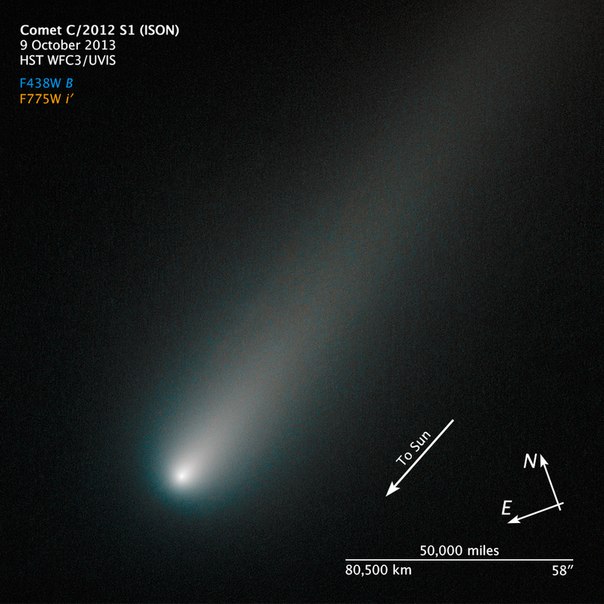
I have long been waiting for what paranoid people would think up after a fabulous bummer with the end of the world in 2012. And, finally, they were delivered. People since ancient times were afraid of comets, even when they more or less understood the origin of these celestial phenomena. Now global comet panic no longer cause. However, ISON provided loud PR scientists themselves: "brighter than the Moon", "comet of the century", and this created grounds for attempts to intimidate the uneducated masses. True, the scale is local: the comets are seriously afraid, it seems, only in Russia. Western ufologists simply savor fake videos featuring the comet's “escort ships”.
')
Let's see if comet C / 2012 S1 (ISON) poses any danger.
Comet ISON is named after the remote monitoring network of the International Scientific Optical Network ( Pulkovo Cooperation of Optical Observers ). Discoverers Vitaly Nevsky and Artem Novichonok at first took her for an asteroid, so the comet did not receive their names.
When ISON was first discovered in 2012, preliminary estimates of its size and trajectory suggested that it would be very noticeable in the sky of the earth. Therefore, there was hope that it would be a big comet .
However, since then it has approached considerably, it has been studied with the help of interplanetary, orbital and ground-based telescopes. Therefore, estimates of the scale of the event have changed significantly, and now only as a result of a very successful set of circumstances can we see it at all with the naked eye.
Let's take a closer look, what flies to us.
One of the first interesting observations was made in January 2013 by the interplanetary station NASA Deep Impact, which rotates in the asteroid belt between Mars and Jupiter. She significantly exceeded the estimated resource of her work, studied everything she could reach and flew around for a long time. In fact, the ISON survey was the last big thing for the station - in August 2013, the connection with it was interrupted, and in September NASA experts announced the final loss of the device.
The next important shot of the comet was the Hubble space telescope.
A series of surveys conducted in April and May, from a distance of 650 million km, made it possible to view the comet much better. I even managed to make a small time-lapse:
When the comet crossed the orbit of Jupiter and headed towards Mars, it became clear that we should not wait for the epochal spectacle. The forecasts of astronomers were becoming more modest and more modest: the brightness of the comet lagged behind the optimistic assumptions, and the activity of the formation of coma (atmosphere and tail) did not justify the expectations.
I was looking forward to the results of the observations of the comet at the end of September and the beginning of October, carried out by the Martian orbital stations and the Mars rovers. But as a result, Curiosity could not even see the comet in the sky, and the half-meter telescope of the MRO satellite sent quite a frivolous trifle:

Here we must understand that the difference between shooting Hubble and MRO is that the first one shot the comet entirely - with its coma, the diameter of which was about 50 thousand km, and the second - only the core, with a diameter of about 2 km.
Today, the observation of a comet is available to almost all owners of more or less serious telescopes. For example, a snapshot of a telescope with a diameter of 10.5 cm:
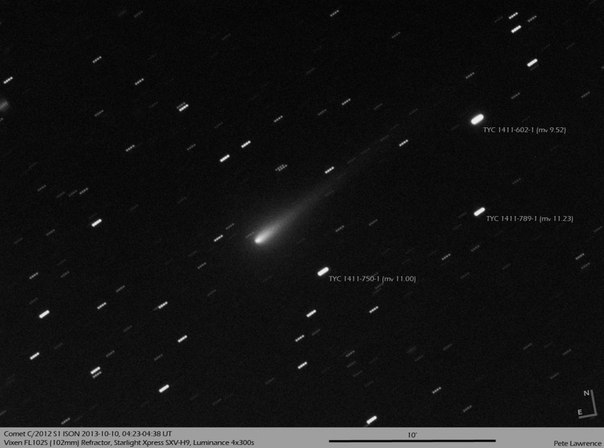
Now a comet is watched by dozens of professionals and amateurs, regular reports and fresh images from around the world can be easily found if you set such a goal. A little more and it can already be photographed on ordinary cameras with telephoto lenses. True, this will require a clear sky, no flare, and straight arms from the shoulders.
While NASA imitated inaction, the Hubble research team conducted new ISON surveys on October 9 (photo at the beginning of the article). This study allowed us to clarify the diameter of the core - 2 km, and make sure that it has not lost its integrity.
Now let's talk about the trajectory.
Although comet ISON will fly closer to Earth than recent guest Panstarrs, anyway, we will be separated by a considerable distance. The maximum convergence of ISON and the Earth will occur on December 26, and the distance will be about 64.2 million km. For example, this is greater than the distance from Earth to Mars at the time of closest approach, and is 167 distances from Earth to the Moon. Therefore, as the probability of Mars falling to the Earth is excluded, there is no danger of ISON falling on our planet.
The ISON trajectory can be traced in the Orbit Diagram service in the USA or in the user- friendly interactive site solarsystemscope.com .
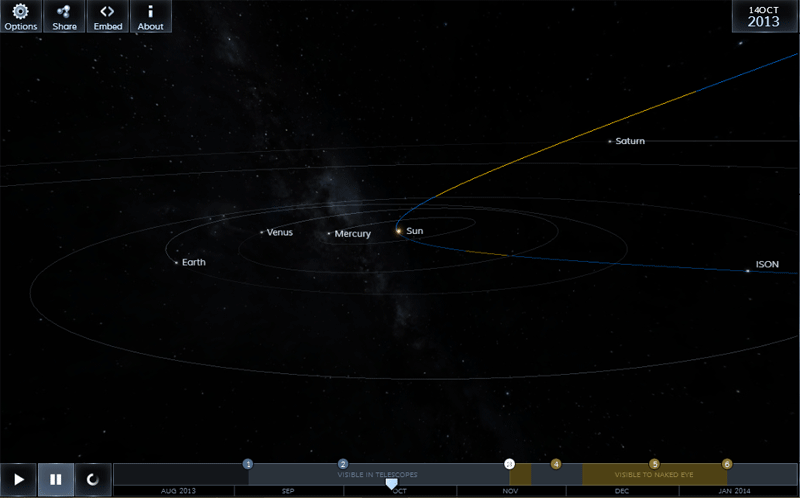
But supporters of the theory of "my ghost" came up with an excuse on this point: what if a comet explodes, and its fragments fall on us?
Let's start with the fact that until Bruce Willis strikes the ISON with a rig and an atomic bomb, there is no threat of a comet exploding at all. But a comet can break up into several fragments. This is a very likely outcome of a close approach between the comet and the Sun, and such events have been observed previously many times.
ISON should pass at a distance of 1.1 million km from the surface of the star. From gravitational effects and tidal forces, it can be divided into several fragments. A similar situation was observed during the fall of comet D / 1993 F2 (Shoemakers-Levy) on Jupiter. What is significant: all the pieces of the fractured comet continued their normal movement in the same orbit.
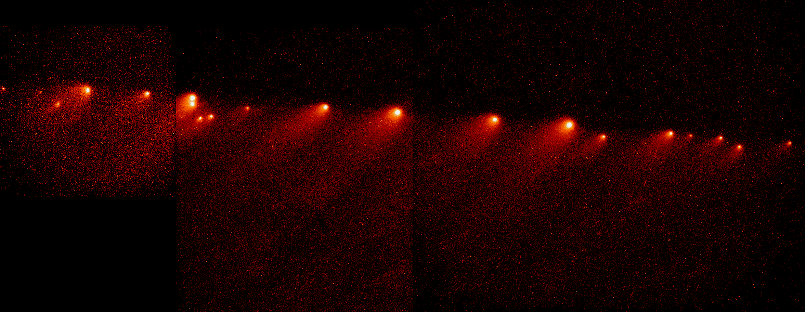
A comet can also collapse under the influence of internal processes. For example, the paranoids' previous hope, comet Elenin, broke up on the approach to the Sun, and only a barely visible cloud of dust and gas came close to the Earth.
The short-period comet of Schwassmann-Wachmann has been falling apart since 1995:
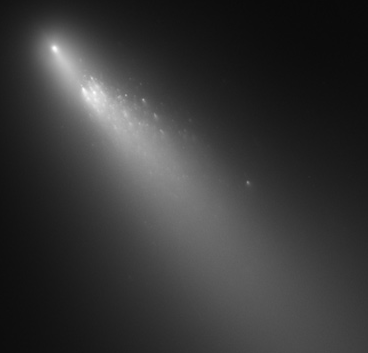
With each three-year orbit of this comet, the wreckage becomes more and more, but they all continue to follow the same trajectory. By the way, this “tailed star” is a good example of what happens to a decaying, but not evaporated comet: large fragments continue to split, and gradually move away from the nucleus. This happens from the difference of gravitational perturbations of celestial bodies, next to which fragments can fly. Depending on the distance to the fragment, the gravitational fields affect them differently, therefore, gradually the comet's tail becomes wider and wider, but the former orbit remains. The expansion speed of the tail is only 45 km / h.
And the collapse of the comet Linear, scientists managed to catch almost in the "live":
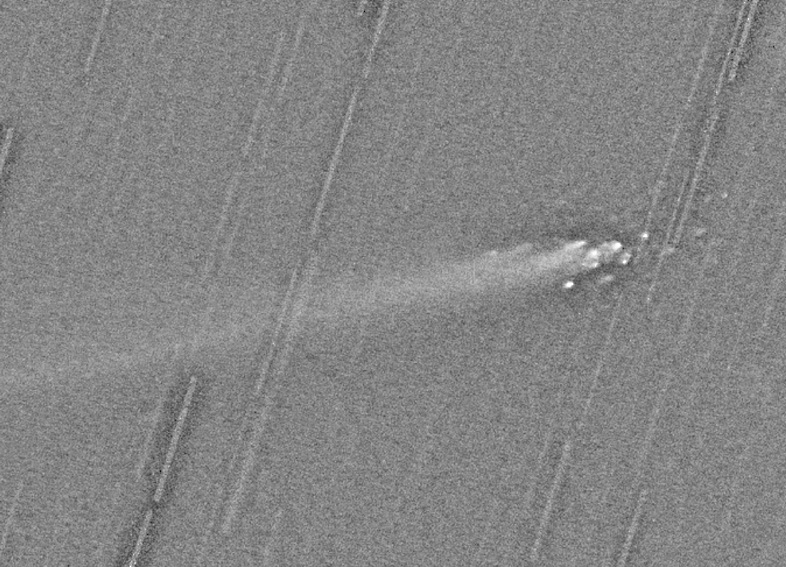
It is possible that this will happen again with ISON, but unlike the Schwassmann-Wachmann, the current comet is a long-period one. Its next return is expected only in 2 million years, therefore in one month its fragments will not have time to deviate from the previous orbit by 60 million km. That is, if the comet falls apart right now, at the time of its closest approach to the Earth, its fragments will be closer to us by about 75 thousand km, which is an insignificant miser on a cosmic scale.
Yes, the Earth in January will come closer to the tail of comet ISON, but it will be the tail that remained from the comet to its convergence with the Sun, i.e. large fragments will not be there. Passing through the tail of a comet in itself for the Earth and earthlings is not scary. Actually, our planet regularly crosses the orbits of comets through which the very "tails" are stretched. In the days of the meeting of the Earth and the "tail" are observed meteor showers. Probably everyone was admiring the falling stars in the August sky, but not everyone thought that they were observing the result of the Earth crossing the orbit of comet Swift-Tuttle. Let's hope that we are lucky with the weather and ISON will give us a colorful spectacle, even if it does not appear in the sky itself.
Now let's talk about fakes that grew up on medieval fears.
Let's look at photos and videos that are not already the first day of discussion in the forums of ufologists.
The basis for the new myth: “ISON is accompanied by two ships” has become a phenomenon, the essence of which is amply reflected in the proverb: “they do not seem to work for fools”.
On April 30, 2013, NASA published a wonderful color snapshot of a portion of the celestial sphere where comet ISON was observed.
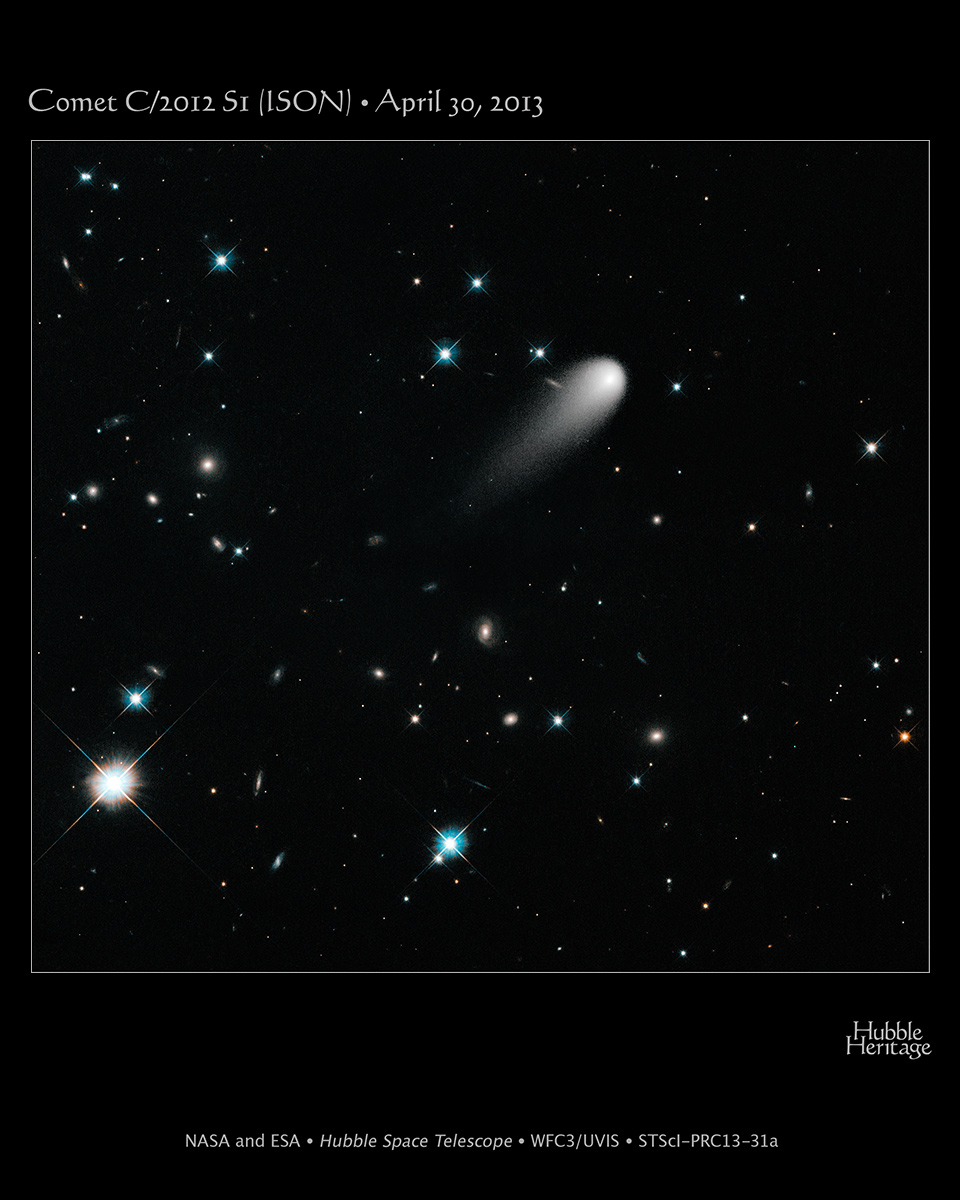
In this case, all the objects turned out in color, and the comet is black and white. As you know, any color digital image is the result of triple shooting through three color channels. But due to the fact that the comet and the telescope move in their orbits, and the exposure takes a certain time (up to 490 seconds), it is impossible to reduce the channels so that all objects of the survey remain in place. The picture was made by the stars, and the comet was left without color. But this was only the beginning. In addition to the finished published snapshot, in the archive of the raw images of the Hubble telescope were placed those three pictures in different color channels from which the color was assembled. On each of these frames, the comet was in a different position, with the long exposure during shooting, which led to the image of the comet's nucleus being elongated. The position of the orbital telescope relative to the comet has also changed; therefore, different exposures captured different positions of the nucleus relative to a much more distant background.

Someone found these images, combined them into one and received a “comet with an accompaniment”.

The virus was launched and soon there were those who decided to play it. In the fall, two (and maybe more) videos appeared on YouTube that demonstrate a supposedly radar shot of the comet's core. The video is positioned as the result of the work of some Chinese satellite:
The second video also demonstrates “accompaniment”, only the name of the “Chinese radar” is clarified:
First, let's deal with the "radar". Tianlian I (Sky Chain) is a series of geostationary satellite repeaters that provide stable communications between Shenzhou spacecraft and Tiangong station and the Earth. In this, its function is similar to the American TDRS or our Ray.

Apparently the falsifiers decided to assign radar functions to them after seeing the unfolded plates.
But even if these devices were radars, and worked in the radio interferometer mode with super-long bases , they still could not give a picture that collects views on YouTube. Mistake counterfeiters was the date of shooting. Knowing it, you can easily determine the distance to the comet, calculate the angular size of the nucleus and evaluate the ability to get the picture shown. On September 3, 2013, the ISON comet was located at a distance of approximately 450 million km. The size of the cometary nucleus is 2 km. Based on this, we consider using the formula a = arctan (d / L) for its angular size and we get about 10 angular microseconds or microseconds of the arc. That is, having a radio telescope with such a resolution, we would see the core as a dot, and in the video the details are higher by orders of magnitude. But let's stop at 10 microseconds. Is it a lot or a little?
Today in astronomy the highest resolution in the radio band (and in any other) was obtained at the international Radioastron project using the Russian space telescope Spectr-R and the network of ground radio telescopes in Russia, Europe and the USA. The maximum resolution reached by him is 27 microseconds of arc, i.e. 3 times more than that required to observe the comet's nucleus. Radioastron is a unique project, the experience of which China only hopes to repeat in the future. The Spektr-R spacecraft moves away from the Earth by tens of thousands of kilometers and this makes it possible to receive data in the radio interferometry mode with superlong bases, as if the Earth had a radar with a diameter of Saturn (without a ring). Apart from Radioastron, neither China nor the rest of the world has such a radar. You can, of course, refer to the closed nature of China, and his gloomy scientific genius, but if they had such a telescope they would actively use it in their propaganda work, as they do with manned flights or probes to explore the moon.
In addition, such a high resolution as 27 microseconds of the arc was obtained by investigating the radio source, but the comet is not. Asteroids flying by the Earth, explore radar irradiating them, but the orbiter will not find enough energy to irradiate the object for 450 million km.
The following detail, which the creators of fakes about the comet do not take into account, is the principle of obtaining a radar image. In the first video, we are shown a comet as if we are looking at it "in the forehead" (even this is not true, because it now flies at an angle of about 45 degrees to the axis of observation), but the radar is not a video camera, we get data on reflection of the signal so the image is visible in the profile:
Here at the shooting of the asteroid 1998 QE2 (by the way, with the “accompaniment”), the radar acts as a source of illumination, and not the Sun, as it might seem. And we observe the object just in profile. The same principle gets the image when doing ultrasound:
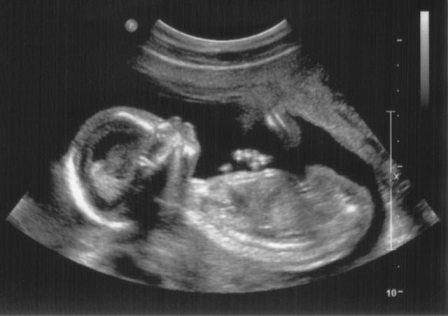
The second video “from the Chinese radar” has one more blunder: it demonstrates the direction of the comet's tail, and during the video this direction changes by 180 degrees. The tail of the comet is always directed in the opposite direction from the Sun, therefore such a change in the direction of the tail is possible in two cases: either the comet flew around the Sun during the filming, or was filmed from a spacecraft that flew around the comet. Of course, neither of these things happened, therefore, even if a radar could be found that could give an image of such a quality, it would show us something completely different.
Here, for example, a real shot of the passage past Tempel 1 comet NASA Stardust
Contrary to the pessimistic expectations of many astronomers, I still hope that the comet will not collapse at the Sun, evaporates to a rapprochement with the Earth, and everyone will enjoy the beautiful night sight. I also hope that this spectacle will make those who now believe stupid threats about the danger posed by ISON think.

I have long been waiting for what paranoid people would think up after a fabulous bummer with the end of the world in 2012. And, finally, they were delivered. People since ancient times were afraid of comets, even when they more or less understood the origin of these celestial phenomena. Now global comet panic no longer cause. However, ISON provided loud PR scientists themselves: "brighter than the Moon", "comet of the century", and this created grounds for attempts to intimidate the uneducated masses. True, the scale is local: the comets are seriously afraid, it seems, only in Russia. Western ufologists simply savor fake videos featuring the comet's “escort ships”.
')
Let's see if comet C / 2012 S1 (ISON) poses any danger.
Comet ISON is named after the remote monitoring network of the International Scientific Optical Network ( Pulkovo Cooperation of Optical Observers ). Discoverers Vitaly Nevsky and Artem Novichonok at first took her for an asteroid, so the comet did not receive their names.
When ISON was first discovered in 2012, preliminary estimates of its size and trajectory suggested that it would be very noticeable in the sky of the earth. Therefore, there was hope that it would be a big comet .
However, since then it has approached considerably, it has been studied with the help of interplanetary, orbital and ground-based telescopes. Therefore, estimates of the scale of the event have changed significantly, and now only as a result of a very successful set of circumstances can we see it at all with the naked eye.
Let's take a closer look, what flies to us.
One of the first interesting observations was made in January 2013 by the interplanetary station NASA Deep Impact, which rotates in the asteroid belt between Mars and Jupiter. She significantly exceeded the estimated resource of her work, studied everything she could reach and flew around for a long time. In fact, the ISON survey was the last big thing for the station - in August 2013, the connection with it was interrupted, and in September NASA experts announced the final loss of the device.
The next important shot of the comet was the Hubble space telescope.
A series of surveys conducted in April and May, from a distance of 650 million km, made it possible to view the comet much better. I even managed to make a small time-lapse:
When the comet crossed the orbit of Jupiter and headed towards Mars, it became clear that we should not wait for the epochal spectacle. The forecasts of astronomers were becoming more modest and more modest: the brightness of the comet lagged behind the optimistic assumptions, and the activity of the formation of coma (atmosphere and tail) did not justify the expectations.
I was looking forward to the results of the observations of the comet at the end of September and the beginning of October, carried out by the Martian orbital stations and the Mars rovers. But as a result, Curiosity could not even see the comet in the sky, and the half-meter telescope of the MRO satellite sent quite a frivolous trifle:

Here we must understand that the difference between shooting Hubble and MRO is that the first one shot the comet entirely - with its coma, the diameter of which was about 50 thousand km, and the second - only the core, with a diameter of about 2 km.
Today, the observation of a comet is available to almost all owners of more or less serious telescopes. For example, a snapshot of a telescope with a diameter of 10.5 cm:

Now a comet is watched by dozens of professionals and amateurs, regular reports and fresh images from around the world can be easily found if you set such a goal. A little more and it can already be photographed on ordinary cameras with telephoto lenses. True, this will require a clear sky, no flare, and straight arms from the shoulders.
While NASA imitated inaction, the Hubble research team conducted new ISON surveys on October 9 (photo at the beginning of the article). This study allowed us to clarify the diameter of the core - 2 km, and make sure that it has not lost its integrity.
Now let's talk about the trajectory.
Although comet ISON will fly closer to Earth than recent guest Panstarrs, anyway, we will be separated by a considerable distance. The maximum convergence of ISON and the Earth will occur on December 26, and the distance will be about 64.2 million km. For example, this is greater than the distance from Earth to Mars at the time of closest approach, and is 167 distances from Earth to the Moon. Therefore, as the probability of Mars falling to the Earth is excluded, there is no danger of ISON falling on our planet.
The ISON trajectory can be traced in the Orbit Diagram service in the USA or in the user- friendly interactive site solarsystemscope.com .

But supporters of the theory of "my ghost" came up with an excuse on this point: what if a comet explodes, and its fragments fall on us?
Let's start with the fact that until Bruce Willis strikes the ISON with a rig and an atomic bomb, there is no threat of a comet exploding at all. But a comet can break up into several fragments. This is a very likely outcome of a close approach between the comet and the Sun, and such events have been observed previously many times.
ISON should pass at a distance of 1.1 million km from the surface of the star. From gravitational effects and tidal forces, it can be divided into several fragments. A similar situation was observed during the fall of comet D / 1993 F2 (Shoemakers-Levy) on Jupiter. What is significant: all the pieces of the fractured comet continued their normal movement in the same orbit.

A comet can also collapse under the influence of internal processes. For example, the paranoids' previous hope, comet Elenin, broke up on the approach to the Sun, and only a barely visible cloud of dust and gas came close to the Earth.
The short-period comet of Schwassmann-Wachmann has been falling apart since 1995:

With each three-year orbit of this comet, the wreckage becomes more and more, but they all continue to follow the same trajectory. By the way, this “tailed star” is a good example of what happens to a decaying, but not evaporated comet: large fragments continue to split, and gradually move away from the nucleus. This happens from the difference of gravitational perturbations of celestial bodies, next to which fragments can fly. Depending on the distance to the fragment, the gravitational fields affect them differently, therefore, gradually the comet's tail becomes wider and wider, but the former orbit remains. The expansion speed of the tail is only 45 km / h.
And the collapse of the comet Linear, scientists managed to catch almost in the "live":

It is possible that this will happen again with ISON, but unlike the Schwassmann-Wachmann, the current comet is a long-period one. Its next return is expected only in 2 million years, therefore in one month its fragments will not have time to deviate from the previous orbit by 60 million km. That is, if the comet falls apart right now, at the time of its closest approach to the Earth, its fragments will be closer to us by about 75 thousand km, which is an insignificant miser on a cosmic scale.
Yes, the Earth in January will come closer to the tail of comet ISON, but it will be the tail that remained from the comet to its convergence with the Sun, i.e. large fragments will not be there. Passing through the tail of a comet in itself for the Earth and earthlings is not scary. Actually, our planet regularly crosses the orbits of comets through which the very "tails" are stretched. In the days of the meeting of the Earth and the "tail" are observed meteor showers. Probably everyone was admiring the falling stars in the August sky, but not everyone thought that they were observing the result of the Earth crossing the orbit of comet Swift-Tuttle. Let's hope that we are lucky with the weather and ISON will give us a colorful spectacle, even if it does not appear in the sky itself.
Now let's talk about fakes that grew up on medieval fears.
Let's look at photos and videos that are not already the first day of discussion in the forums of ufologists.
The basis for the new myth: “ISON is accompanied by two ships” has become a phenomenon, the essence of which is amply reflected in the proverb: “they do not seem to work for fools”.
On April 30, 2013, NASA published a wonderful color snapshot of a portion of the celestial sphere where comet ISON was observed.

In this case, all the objects turned out in color, and the comet is black and white. As you know, any color digital image is the result of triple shooting through three color channels. But due to the fact that the comet and the telescope move in their orbits, and the exposure takes a certain time (up to 490 seconds), it is impossible to reduce the channels so that all objects of the survey remain in place. The picture was made by the stars, and the comet was left without color. But this was only the beginning. In addition to the finished published snapshot, in the archive of the raw images of the Hubble telescope were placed those three pictures in different color channels from which the color was assembled. On each of these frames, the comet was in a different position, with the long exposure during shooting, which led to the image of the comet's nucleus being elongated. The position of the orbital telescope relative to the comet has also changed; therefore, different exposures captured different positions of the nucleus relative to a much more distant background.

Someone found these images, combined them into one and received a “comet with an accompaniment”.

The virus was launched and soon there were those who decided to play it. In the fall, two (and maybe more) videos appeared on YouTube that demonstrate a supposedly radar shot of the comet's core. The video is positioned as the result of the work of some Chinese satellite:
The second video also demonstrates “accompaniment”, only the name of the “Chinese radar” is clarified:
First, let's deal with the "radar". Tianlian I (Sky Chain) is a series of geostationary satellite repeaters that provide stable communications between Shenzhou spacecraft and Tiangong station and the Earth. In this, its function is similar to the American TDRS or our Ray.

Apparently the falsifiers decided to assign radar functions to them after seeing the unfolded plates.
But even if these devices were radars, and worked in the radio interferometer mode with super-long bases , they still could not give a picture that collects views on YouTube. Mistake counterfeiters was the date of shooting. Knowing it, you can easily determine the distance to the comet, calculate the angular size of the nucleus and evaluate the ability to get the picture shown. On September 3, 2013, the ISON comet was located at a distance of approximately 450 million km. The size of the cometary nucleus is 2 km. Based on this, we consider using the formula a = arctan (d / L) for its angular size and we get about 10 angular microseconds or microseconds of the arc. That is, having a radio telescope with such a resolution, we would see the core as a dot, and in the video the details are higher by orders of magnitude. But let's stop at 10 microseconds. Is it a lot or a little?
Today in astronomy the highest resolution in the radio band (and in any other) was obtained at the international Radioastron project using the Russian space telescope Spectr-R and the network of ground radio telescopes in Russia, Europe and the USA. The maximum resolution reached by him is 27 microseconds of arc, i.e. 3 times more than that required to observe the comet's nucleus. Radioastron is a unique project, the experience of which China only hopes to repeat in the future. The Spektr-R spacecraft moves away from the Earth by tens of thousands of kilometers and this makes it possible to receive data in the radio interferometry mode with superlong bases, as if the Earth had a radar with a diameter of Saturn (without a ring). Apart from Radioastron, neither China nor the rest of the world has such a radar. You can, of course, refer to the closed nature of China, and his gloomy scientific genius, but if they had such a telescope they would actively use it in their propaganda work, as they do with manned flights or probes to explore the moon.
In addition, such a high resolution as 27 microseconds of the arc was obtained by investigating the radio source, but the comet is not. Asteroids flying by the Earth, explore radar irradiating them, but the orbiter will not find enough energy to irradiate the object for 450 million km.
The following detail, which the creators of fakes about the comet do not take into account, is the principle of obtaining a radar image. In the first video, we are shown a comet as if we are looking at it "in the forehead" (even this is not true, because it now flies at an angle of about 45 degrees to the axis of observation), but the radar is not a video camera, we get data on reflection of the signal so the image is visible in the profile:
Here at the shooting of the asteroid 1998 QE2 (by the way, with the “accompaniment”), the radar acts as a source of illumination, and not the Sun, as it might seem. And we observe the object just in profile. The same principle gets the image when doing ultrasound:

The second video “from the Chinese radar” has one more blunder: it demonstrates the direction of the comet's tail, and during the video this direction changes by 180 degrees. The tail of the comet is always directed in the opposite direction from the Sun, therefore such a change in the direction of the tail is possible in two cases: either the comet flew around the Sun during the filming, or was filmed from a spacecraft that flew around the comet. Of course, neither of these things happened, therefore, even if a radar could be found that could give an image of such a quality, it would show us something completely different.
Here, for example, a real shot of the passage past Tempel 1 comet NASA Stardust
Contrary to the pessimistic expectations of many astronomers, I still hope that the comet will not collapse at the Sun, evaporates to a rapprochement with the Earth, and everyone will enjoy the beautiful night sight. I also hope that this spectacle will make those who now believe stupid threats about the danger posed by ISON think.
Source: https://habr.com/ru/post/198034/
All Articles